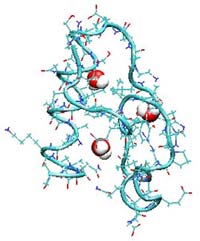Latest News

Telecoms: Important step to better network performance
Today, Eurescom, Spirent Communications, and BTexact Technologies announced the completion of a test that confirms the feasibility of performance management for IP Quality of Service (QoS) using Multiprotocol Label Switching (MPLS).
As a result of this test, service providers will be able to employ a simplified methodology for identifying the location of performance problems across multiple operator networks, and for verifying their capability to capture performance information at various cl

New compound holds promise for lupus and related diseases
A chemical cousin of anti-anxiety medications, such as Valium and Xanax, significantly reduces kidney inflammation in mice inbred to develop a disease resembling human systemic lupus erythematosus (SLE), researchers at the University of Michigan and the University of California-Berkeley have found.
Their research, described in the Oct. 16 issue of the Journal of Clinical Investigation, also reveals the novel mechanism by which the compound works, a discovery that could lead to safer and mor

Protein patterns in blood may predict prostate cancer diagnosis
Patterns of proteins found in patients’ blood serum may help distinguish between prostate cancer and benign conditions, scientists from the National Cancer Institute (NCI) and the Food and Drug Administration (FDA) report today in the Journal of the National Cancer Institute*. The technique, which relies on a simple test using a drop of blood, may be useful in deciding whether to perform a biopsy in men with elevated prostate specific antigen (PSA) levels.
Using a test that can analyze

New studies advance scientific knowledge of drinking water disinfection byproducts
Studies published in International Journal of Toxicology
In its September/October issue, the International Journal of Toxicology is pleased to publish the last in a series of four studies examining possible reproductive and developmental health effects from two byproducts of drinking water chlorination. These studies fill significant data gaps identified by a Federal Advisory Committee formed by the U.S. Environmental Protection Agency (EPA) on drinking water regulations.
Sm

Cystic fibrosis gene mutations missing from some cases
A new study from Johns Hopkins finds that some patients diagnosed with cystic fibrosis (CF) lack any of the more than 1,000 reported disease-causing mutations in the only known CF gene. Scheduled for presentation Oct. 18 at the annual meeting of the American Society for Human Genetics in Baltimore, the findings also recently appeared in the New England Journal of Medicine.
The discovery may mean that another gene, as yet unidentified, is to blame for these cases, or perhaps these patients r

Protein folding physics modeled at the atomic level
Researchers at Los Alamos National Laboratory and the University of California, San Diego, have created the first computer simulation of full-system protein folding thermodynamics at the atomic-level. Understanding the basic physics of protein folding could solve one of the grand mysteries of computational biology.
Proteins are the basic building blocks of life and protein folding, the process by which proteins reconfigure themselves – the actions that result in structural change – are the










